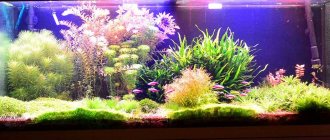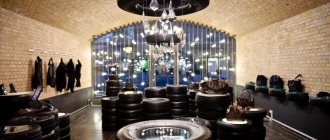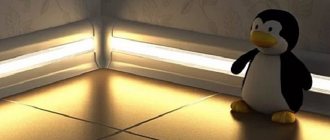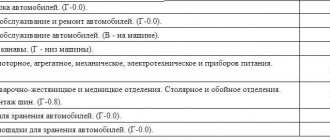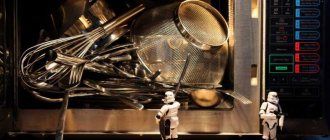Store-bought LED seedling lamps are not intended for seedlings. They are suitable for greenhouses, winter gardens and illumination of indoor plants. The spectrum of their LEDs is dominated by red, which helps increase green mass. There is no need for seedlings to increase green mass; on the contrary, they need a strong root system.
The spectrum of LED lamps intended for illumination of seedlings should contain much more blue.
The design of a budget LED lamp for seedlings was invented by a highly respected FORUMHOUSE user with the nickname Liftanuty and has been successfully tested by many forum users.
Budget lamp: number and ratio of LEDs
LEDs are the most low-budget component of this budget project; it is important to buy as many of them as you need. FORUMHOUSE user Liftanuty, based on his experience, derived the following formula:
Required number of LEDs = 50 LEDs 1W x 1 sq. meter of seedlings.
So, to organize full illumination of seedlings on a window sill one and a half meters long and 30 cm wide, you will need 25 LEDs (it is better to round up to 24).
These are the minimum requirements.
The less light the window provides, the more LEDs should be in the lamp.
Some FORUMHOUSE users recommend an LED power of 100 W/sq.m.
The ratio of red and blue LEDs depends on the time of planting of seedlings. If all forecasts and signs indicate that the seedlings will be planted on time, the optimal ratio of red to blue is 2:1. If you are not sure about the timing, then it is better to use more blue, up to 1:1. Under such a lamp, the seedlings will be able to wait for planting without stretching or getting sick.
Ratios of red and blue
| Timing for planting seedlings | Red Blue |
| during | 2:1 |
| dont clear | 1:1 |
The blue color retards the development of green mass and stimulates the development of roots.
How to make your own phytolamp from LED strip
The easiest way to make a phytolamp with your own hands is to use an LED strip. It is based on a flexible plastic material with built-in conductive tracks, which means you can make a lamp that will follow the contours you need.
The required power of the power supply is calculated quite simply. To do this, you need to find out the power consumption of the LED strip. The tape power is fixed: 4.8W/m, 7.2W/m and 14.4W/m. We look at the value on our tape and multiply by meters. Thus, you can easily calculate the power of the power supply.
What we need:
- LED strips for 12 volts: 2 m with red LEDs and 30 cm with blue ones. The photo lamp will be square in size on a canvas of 20x20 cm.
- Rigid PVC sheet 2 mm thick, size 20x20 cm. Similar to plastic, can be bought at any hardware store.
- Power connector for LED strip
- A power supply with a voltage of 12V and sufficient power to power our LED strip.
Connector for connecting LED strip
There are two main types of LEDs: SMD 3028 and SMD 5050. The numbers 3028 and 5050 indicate the size of the LED in millimeters, so they measure 3.0 by 2.8 mm and 5.0 by 5.0 mm respectively.
For example, let's take a tape of a fixed length - 2.6 meters, with a consumption of 4.8 V / m. By simple calculations, we obtain the required power of the power supply of 12.5 V (we multiply the length of the LED strip in meters by its power: 2.6 m x 4.8 V/m = 12.48 V). We select a power supply with a power of at least 13 Watts (with a margin).
To begin, cut the ribbons into 20 cm pieces. You get 10 red ribbons and 3 blue ones. We place them on the PVC sheet in the following order: 3 red, 1 blue, 2 red, 1 blue, 2 red, 1 blue, 3 red.
As a basis for a phytolamp, you can use not only a PVC sheet, but also, for example, a sheet of plastic, polycarbonate or metal.
There are LED strips with and without an adhesive layer. Tape with an adhesive layer is not the best option, because it can peel off and you will have to constantly re-glue it. Therefore, no matter what type of tape you use, be sure to glue the base of the LED tape of the future phytolamp with heat-resistant glue. Next you need to solder the pieces of tape with wires. Remember to observe polarity! At the end we connect the connector to connect to the power supply. This is what the finished design should look like:
Ready-made phytolamp from pieces of tape
All that remains is to place the LED strip phytolamp over the plants, connect the power supply and turn it on.
The video shows an alternative way to assemble a phytolamp from an LED strip. A strip with 5730 LEDs is used. A cable channel is used to attach the strip to the base – the board.
Components of the structure
To make a budget LED lamp for seedlings you will need:
- LEDs with a power of 1-3 watts, blue (440nm) and red (660nm);
The light wavelength given in brackets shows that the LED is intended specifically for illuminating plants.
- Any aluminum profile;
- Insulated mounting section 0.2 -0.5 sq. mm;
- Thermal paste or hot glue;
- Power cord with plug;
- Power supply.
How to make an LED lamp cheaply - buy LEDs at a popular online auction. Enter “led 1W 660nm” into the search bar.
Calculation of the required light
In order for a phytolight to really accelerate plant growth, it is necessary to correctly calculate its parameters. The main optical characteristic of any light source is the luminous flux, which indicates how much light power (lumens) the lamp produces. Its value is indicated on the packaging. In turn, for plants the main indicator is illumination, indicating the number of lumens in 1 m2.
The luminous flux required for effective illumination is calculated using the formula Ф = E×S/Ki, where:
F – luminous flux, lm; E – required illumination, the value of which is set individually for each type of plant, lux; S – area to be illuminated, m2; Ki is a coefficient that takes into account light loss due to scattering.
In lamp luminaires with a poor reflector, due to the lack of a strictly directional glow, the Ki value can reduce the efficiency of the lamp by more than half. The LED has a directional glow, the angle of propagation of which is determined by the lens. In this regard, in LED lamps the reflector does not have such a strong effect on the efficiency of the lighting system as a whole, and Ki reaches 0.8–0.9 units.
And yet, illuminating seedlings with LED lamps at home often requires a reflector. This is especially true for phytolights designed on the basis of LED strips, where the reflector helps concentrate the maximum amount of light on the usable area.
Do not forget about the power of the LED lamp and the half-brightness angle, often referred to as the dispersion angle. Sometimes, even a properly assembled phyto-lamp turns out to be ineffective. Excessive distance leads to loss of light power (inverse square law), and a small dispersion angle leads to underlighting at the edges.
LEDs emit heat in the opposite direction to the light output. Therefore, they can be brought as close as possible to the plants, leaving only a few centimeters in reserve.
Lamp frame design
The location of the LEDs depends on the width of the surface on which the seedlings will stand. If this is a window sill less than 25 cm wide, they can be mounted on one ruler, if larger - on two or even three.
ElevatorForumHouse Member
The ruler is a piece of aluminum profile 100 mm shorter than the window sill.
It is important to position the LEDs evenly, and given that each emits a light cone with an angle of 70-120 degrees, so that the projections of these cones slightly overlap each other, as in this diagram by our user with the nickname Liftanuty.
The profile width is calculated based on the fact that for high-quality heat removal from one one-watt LED, 25 sq. cm of surface area is needed.
A symmetrical U-shaped symmetrical profile is best suited for LED strips. Along its edges you need to make stops with a height of 1 mm.
The rulers must be secured in the frame with screws or blind rivets.
Why do seedlings need lighting?
Most gardeners begin planting seeds for seedlings in February or March. Daylight hours at this time of year are short, and seedlings of different crops require 10–16 hours of light per day for harmonious development. When it is deficient, the seedlings become very elongated, the leaves turn pale and wither; after planting in the ground, the plants either do not take root at all, or take a long time to adapt to the new habitat. And on the contrary, those specimens that have had enough light turn out to be powerful, resistant to the vagaries of the weather, they are characterized by a more developed root system, better resistance to diseases and pest attacks and, as a result of all this, increased productivity.
It is impossible to grow high-quality seedlings without good lighting; seedlings do not have enough sunlight at the end of winter and at the beginning of spring
LED installation
Blue and red LEDs on the line are evenly spaced, taking into account the color ratio (red, red, blue, etc.). Before mounting it on the ruler, you should indicate where the LED of a certain color will be attached.
LEDs can be mounted in different ways:
- screws;
- self-tapping screws;
- rivets;
- thermally conductive glue.
For LEDs “on stars”, two mounting holes should be drilled in the line according to the markings. For thermal contact, the LEDs must be tightly pressed to the profile, and for this you need to make a thermal compensating gasket.
It is ideal to use thermally conductive glue from radio stores; it will act as both a fastener and a thermal pad at the same time.
The “plus” of one “LED” is connected to the minus of the other using any radio wiring wire from 0.2 sq. mm. A soldering iron of no more than 40W is used in this work.
There are polarity markings on the LEDs, but there are inconsistencies that are detected by a multimeter in the “continuity” mode.
Power supply
When choosing drivers, the creator of the lamp strongly recommends that you be careful: if the circuit contains a choke with two windings instead of a transformer, then using such a driver to make homemade lamps is life-threatening.
Drivers ordered from China must be checked for the presence of galvanic isolation with a phase indicator, pressing it one by one to the driver output terminals.
viktor50FORUMHOUSE Member
If the indicator does not light up at any output, it means the driver has a transformer; galvanically isolated from the network. If the indicator lights up, there is no decoupling and it is imperative that the sockets are turned on in the panel room through an RCD (residual current device).
Main options and their features
For home use, you should choose one of two options, as they have proven to work best and can be purchased in most stores. Features of each type:
- Fluorescent light sources. A time-tested type that was the only one a couple of decades ago. They can be either tubular or for a standard E27 cartridge. The light power is not very high, but the lamps do not heat up during operation and provide optimal performance. Service life is no more than a year due to phosphor burnout and spectrum distortion.
- LED options allow you to select the optimal radiation and its power, which will simplify the manufacture of a homemade phytolamp. At the same time, diodes consume the least amount of electricity and have a long service life, during which the spectrum is practically not distorted. The products are easy to install, they do not heat up much during operation and do not pose a danger to humans, since they operate on low-voltage power.
Ultraviolet lamp option.
Experience of use
FORUMHOUSE member YurecV assembled such a budget lamp from Chinese LEDs and drivers, as well as an aluminum I-beam from a hardware store.
The lamp has two lines, each with 21 LEDs (10 blue and 32 red), the distance between them is 4.5 cm. The LEDs are attached to the I-beam with autosealant.
The lamp cost a thousand rubles (prices in 2016, but even then it was 4-6 times cheaper than buying a ready-made one) and a day of work: half a day to assemble the frame, mark and attach the LEDs, and another half a day to cut and clean , tin and solder the wires. Between these processes we had to wait a day for the sealant to dry completely.
The LEDs on each line are connected in series, each line has its own driver. The entire design consumes 32 watts.
The lamp heats up, but weakly: up to 41 degrees. It can be lowered closer to the plants without the risk of burning them.
In operation, the lamp showed its best performance; even the light-loving dill under it grows fluffy and spreading.
Summarizing
A DIY LED lamp for seedlings costs several times less than a purchased one. But the main advantage that no amount of money can buy: the correct ratio of red and blue in the spectrum. Such a lamp will illuminate the seedlings evenly over its entire area. And strong, elongated, healthy seedlings are the main condition for an excellent harvest.
On FORUMHOUSE you can learn more about how to make a budget lamp for seedlings using LEDs, read an article by a user with the nickname Liftanuty about the results of experiments on growing seedlings at home under LEDs (and why they are better than phytolamps). You can study the portal’s collective experience in the use of LEDs in crop production. There is an article on the portal that summarizes successful experiences in making racks for seedlings. Learn how to get strong seedlings. Watch a video on how to properly harden and feed adult seedlings.
Subscribe to our Telegram channelExclusive posts every week
Common Mistakes
When creating a phytolamp, the following mistakes are most often encountered:
- Buying cheap components. A low-quality LED phytolibbon will not give the desired effect to plants, and an incorrectly selected driver will lead to poor voltage equalization and rapid lamp failure. The entire set of elements for assembly must be of optimal quality. To do this, it is better to buy goods in a specialized store.
- Incorrect calculation of the cooling system. Poor heat dissipation reduces the operating time of the phytolamp.
- Poor contact between parts. The leakage of the device assembled with your own hands also has an impact.
Compliance with the correct creation of the lamp will allow you to use the device for its intended purpose for many years.



